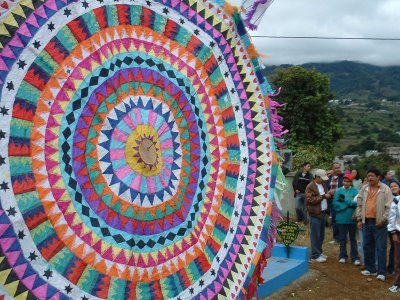
It was no Windsor, not even an Acton, but now that we're married and all, we decided we could officially be considered to be passing the Yuletide with family regardless of our location. Being the rational agents we are, the obvious course of action was to while away the three-day weekend sunning ourselves and drinking beer marginally better than that available in Guatemala. A hasty trip to the beach in El Salvador was clearly in order.
It seems like we were following a noble winter tradition and heading South, but we were in fact heading East as much as anything. You can look on a map if you want. I was surprised, too.
Our shoddy sense of continental geography aside, we found our way to Sunzal beach, home to what are rumored to be "gnarly" surf breaks and "a big crazy shaped rock" (additional illustration above, click to see it way big). The place was dead during daylight on Christmas Eve, which is the big family-gathering holiday in Central America, except for the young gentlemen ogling my lovely wife as she sat on the beach in her not-really-that-provocative swimwear. (Which ogling in fact grew all the more concerted when the beach grew more crowded the next day. I grew up in Colorado, and thus may not be the most well versed in beach etiquette, but even at the topless beaches that I have been lucky enough to patronize, it seems that a certain level of tact, if not outright guile, is required in the ogling department; the beaches of El Salvador are free of such boundaries of circumspection.)
Then, at sunset, the fireworks started. (Rest assured, I'm no longer talking about the inter-gender discourse on the beach, but rather literal pyrotechnics.) Really, fireworks have been visible from our balcony in Guatemala City just about every night for the last month -- and not just sparklers and bottle rockets but Greeley Independence Stampede Fourth-of-July Spectacular-caliber fireworks, which apparently anybody who's anybody in Guatemala City buys for their own personal backyard amusement. Or at least those who think their kids have too many fingers do. Sadly, the fireworks on the beach were not up to that level, but they were a constant background presence for hours and hours, both on Christmas Eve and Christmas Day. As was the reggaeton smash "Gasolina," which the surf-bum hangout next door played at high volume on constant loop by night, which was in turn not unlike their treatment of Bob Marley's "Legend" by day.
(Alas, it's more entertaining to nitpick about minutiae than to make general sweeping statements like "the beach was beautiful and relaxing, and the water was perfect swimming temperature," but that doesn't make the latter any less true. Really, the beach in El Salvador was fantastic. I hope to return.)
Wrapping up our Salvadoran adventure on our way out of town Monday, we made two stops: The standard Central American market in the nearby port town and the "Mayan Pompeii" of Joya del Cerén, where typical Mayan dwellings have been preserved in volcanic ash. The market was a fun diversion, with the jerry-rigged gear of the local fishermen and the ready availability of sipping coconuts and vodka bottles filled with shark oil, which many claim has curative effects for all manner of household maladies and masculine failures. We bought a coconut; we passed on the Aceite de Tiburon.
The Mayan Pompeii, it turns out, is closed on Mondays.





